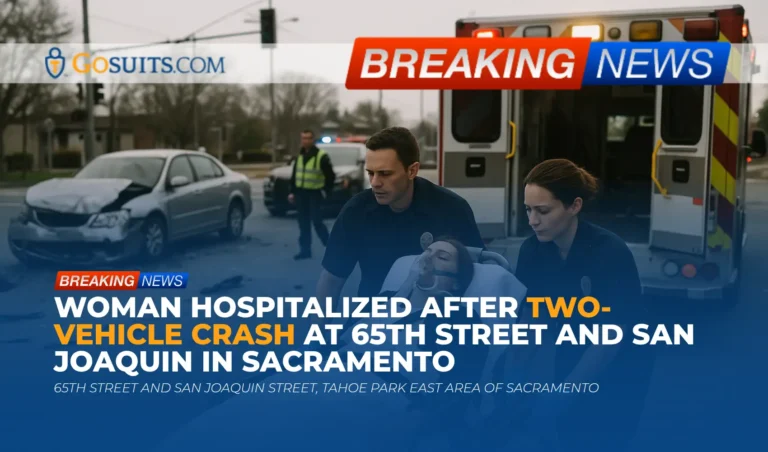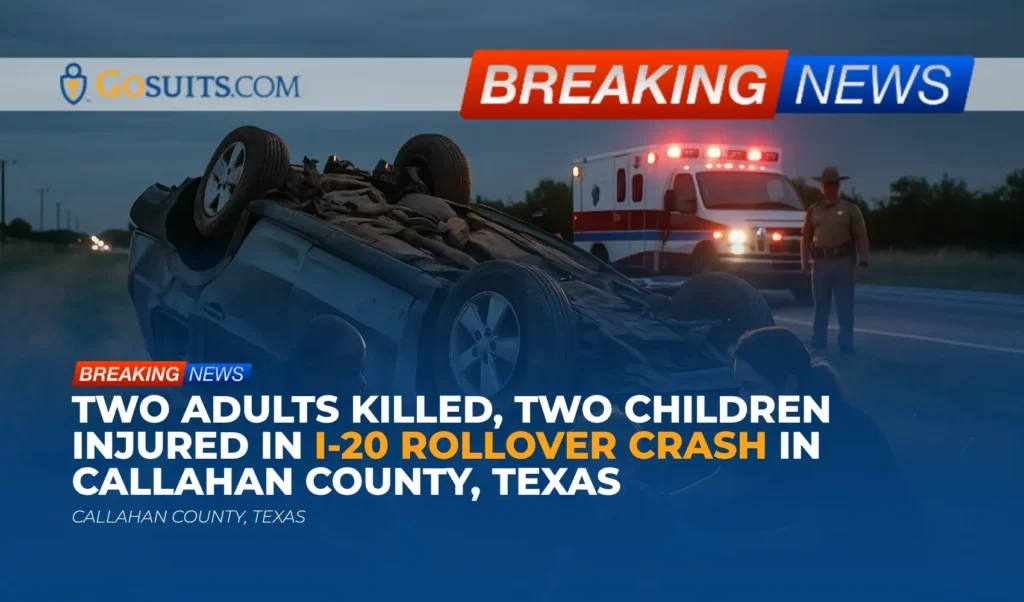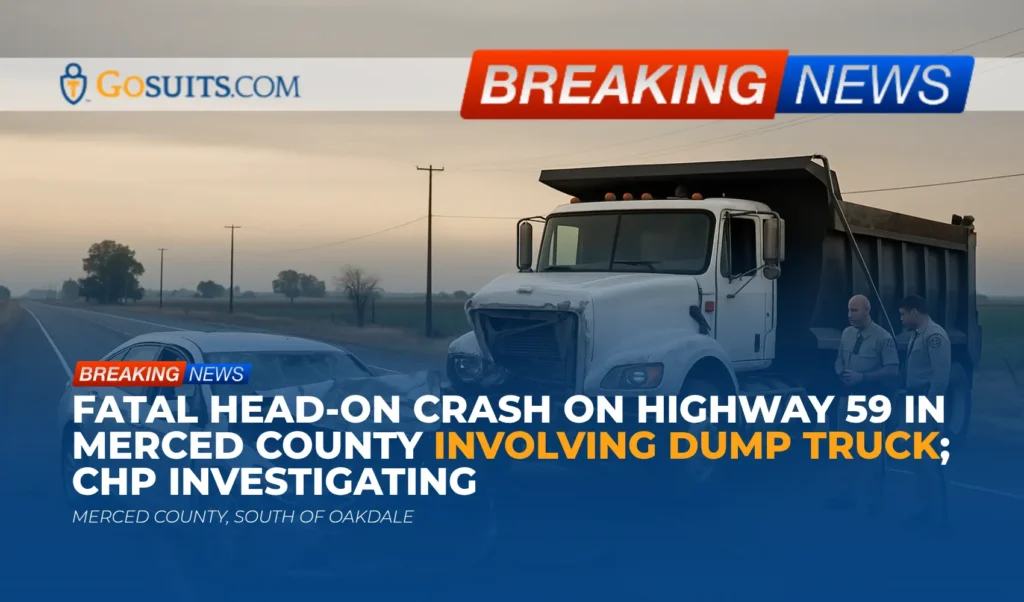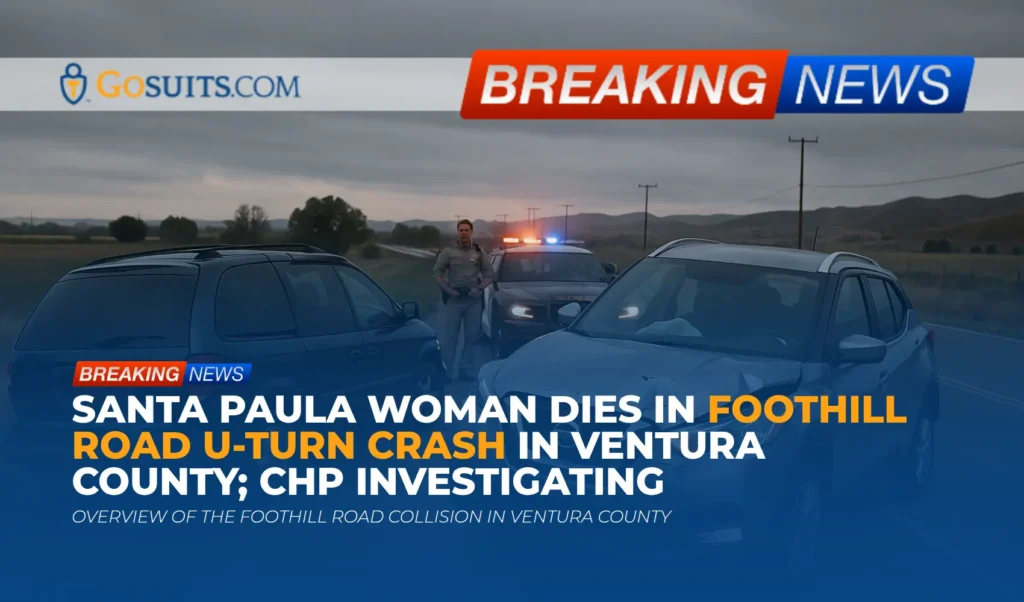- Incident overview
- Where to find official information and records
- Rights and options after a Sacramento traffic collision
- Possible civil liability issues at a two-vehicle intersection crash
- Protecting yourself before speaking with insurers
- Time limits and special notice rules in California
- Safety context for 65th Street and similar urban corridors
- Local points of contact that may help
- Commentary from Gosuits Sacramento, California Personal Injury Attorney
- Why timely action matters now
Incident overview
Early Tuesday morning, a two-vehicle crash was reported at 65th Street and San Joaquin Street in Sacramento’s Tahoe Park East neighborhood. Emergency medical services were dispatched around 7:55 a.m. Dispatch communications indicated a woman was injured and transported to a nearby hospital for treatment. The cause of the crash was not immediately clear, and additional details such as the number of occupants in each vehicle or whether any citations were issued had not been released at the time of reporting.
Intersections like 65th and San Joaquin are busy neighborhood connectors. Morning commute periods add traffic volume, turning movements, and pedestrians on foot or bikes. Even at modest speeds, two-vehicle impacts can cause significant injuries, particularly soft tissue trauma, head and neck injuries, fractures, or internal injuries that may not be immediately apparent. Anyone affected should prioritize medical evaluation and follow-up, even if symptoms feel minor at first.
What we know so far
- Location: 65th Street and San Joaquin Street, Tahoe Park East area of Sacramento.
- Time: Approximately 7:55 a.m. (morning commute period).
- Vehicles: Two vehicles involved.
- Injuries: A woman was transported to a nearby hospital for treatment.
- Cause: Not yet determined or publicly released.
What happens next
In a collision like this, the investigating agency gathers statements, surveys the scene, documents vehicle positions and damage, and may request nearby security or dash-camera footage. Once the collision report is completed and approved, involved parties or their authorized representatives can typically request a copy through the responding agency’s records process. If traffic control devices, signal timing, sightlines, or road conditions are relevant, those factors may also be evaluated in the investigation or through subsequent civil inquiries.
Where to find official information and records
Access to official records can help families understand what happened and plan next steps. The agencies and documents below are commonly involved in Sacramento-area traffic collisions. Availability depends on the investigating authority, privacy rules, and whether the record is complete.
Collision reports
- Which agency holds the report: On city streets, the local police department typically prepares the collision report. On state highways, the California Highway Patrol (CHP) usually handles the investigation. The crash at 65th and San Joaquin is within the City of Sacramento; if the Sacramento Police Department handled it, the report would be requested through the department’s records process. If CHP responded for any reason, requests go to CHP.
- How to request from CHP: The CHP provides guidance for requesting collision reports, including who can obtain them and what identification is required. See: California Highway Patrol: Obtaining Copies of Collision Reports.
- How to request from a city police department: Most departments accept requests from involved parties or their representatives through a records unit. Requests may be processed under the California Public Records Act and agency policies. Provide the date, approximate time, location, and names of involved parties if known.
Emergency medical services (EMS) and fire records
- Patient care reports: Paramedics or fire personnel who responded create a patient care report. An injured patient or an authorized representative can typically request this record. Agencies may require proof of identity and a signed authorization.
- Medical privacy: Federal privacy rules give patients a right to access their medical information, with narrow exceptions. See the U.S. Department of Health and Human Services overview of patient access rights: HHS: Your Rights Under HIPAA.
Hospital records
- Emergency department and inpatient records: The treating hospital can provide records, imaging, and billing statements to the patient or an authorized representative. Hospitals usually require a signed authorization and valid identification.
If a collision involves a fatality
- Coroner’s office: In fatal crashes, the county coroner’s office oversees medicolegal death investigation and may release certain reports to legal next-of-kin. In Sacramento County, information and records are handled through the county’s coroner office. Families can review procedures via the county’s official site: Sacramento County (official site).
- Death certificates: Certified copies of death certificates in California can be requested through county vital records or the state health department. See the California Department of Public Health’s guidance: CDPH: Vital Records.
Rights and options after a Sacramento traffic collision
California civil law provides paths for injured people to seek compensation for medical care, lost wages, pain and suffering, and property damage when another party is legally responsible. The path depends on fault, insurance, and the nature of the injuries. While every case is unique, several statewide rules and protections commonly apply.
Mandatory DMV accident reporting (SR-1)
- Who must report: California requires a driver to report a collision to the DMV within 10 days if anyone is injured (no matter how minor), if anyone is killed, or if property damage appears to be $1,000 or more. This report is required regardless of fault.
- How to report: The SR-1 form can be submitted online or by mail. Details are on the DMV’s official page: DMV: SR-1 Reporting an Accident.
Insurance basics in California (2025)
- Liability coverage minimums increased in 2025: State law increased minimum auto liability limits to $30,000 for injury or death to one person, $60,000 per crash for injury or death to more than one person, and $15,000 for property damage for policies issued or renewed in 2025. See DMV financial responsibility information: DMV: Financial Responsibility.
- Uninsured/underinsured motorist (UM/UIM): UM/UIM can help when the at-fault driver has no insurance or insufficient limits. It often covers medical losses and sometimes lost wages and pain and suffering up to the UM/UIM policy limits.
- Medical payments (MedPay): MedPay can cover reasonable medical expenses for occupants in your vehicle regardless of fault, up to the MedPay limit, without copays or deductibles.
Property damage and rental transportation
- Repairs and totals: If a car is repairable, the at-fault driver’s insurer may pay for reasonable repairs; if it is a total loss, the measure is typically fair market value immediately before the crash.
- Loss-of-use and rentals: Reasonable rental or loss-of-use damages may be recoverable even if you don’t rent a car, but policies differ. Preserve receipts and keep notes of any transportation expenses.
Possible civil liability issues at a two-vehicle intersection crash
Establishing fault at an urban intersection often turns on the right-of-way, compliance with traffic controls, speed, attentiveness, and visibility. The law requires motorists to operate with reasonable care, keep proper lookout, obey traffic controls, and adjust speed for conditions. In practice, a thorough evaluation may consider the following.

Evidence that can clarify what happened
- Scene documentation: Photos or video of resting positions, skid marks, debris, and traffic control devices can help reconstruct the sequence of events.
- Vehicle damage patterns: Crush profiles, paint transfer, and airbag deployments can corroborate angles and speeds.
- Witness accounts: Independent witnesses can be critical in a right-of-way dispute. Prompt collection of names and contact details matters because memories fade.
- Nearby cameras: Residential doorbell cameras, business security systems, and dash cameras on commuter routes often capture critical seconds before and after an impact.
- Phone and telematics data: Where appropriate and lawful, cell phone records or connected-vehicle data may shed light on distraction or speed.
- Signal timing and sightlines: Vegetation, parked vehicles, sun glare, or sign placement can affect what drivers could reasonably see and when.
Common negligence patterns in urban intersection crashes
- Failure to yield: Misjudging gaps or ignoring stop or yield requirements.
- Speed too fast for conditions: Even if within the posted limit, speed can be unsafe for dense neighborhood traffic, limited visibility, or wet pavement.
- Distracted driving: Handheld phone use while driving is unlawful in California. See California Vehicle Code provisions on wireless telephone use: CVC § 23123.
- Improper turns: Cutting across opposing lanes or turning without sufficient clearance from oncoming traffic.
Comparative fault in California
California follows a pure comparative fault rule. If multiple parties share responsibility, each party’s recovery can be reduced by their percentage of fault, but not eliminated. That means careful attention to the facts is important; even when one driver appears primarily at fault, apportionment can still be disputed by insurers and may affect compensation.
Protecting yourself before speaking with insurers
Insurance adjusters may contact people soon after a crash, sometimes while they are still in pain or on medication. While insurers play an important role in resolving claims, early statements can affect how a claim is evaluated.
- Consider consulting an attorney first: A short, free consultation can help clarify rights and typical claim processes. What is said to any insurance company, including your own, can be used later to evaluate liability and damages.
- Be cautious with recorded statements: If you choose to speak to an insurer, stick to basic facts like date, time, location, vehicles involved, and insurance information. Avoid speculating about speed, visibility, or fault before reviewing the evidence and your medical status.
- Document injuries thoroughly: Keep a journal of symptoms, missed work, and daily impacts. Save all receipts and bills for medical care, medications, and transportation.
- Follow medical advice: Attend follow-up appointments and recommended therapy. Gaps in treatment are often used to argue that injuries were minor or unrelated.
Time limits and special notice rules in California
Time limits can determine whether a claim can proceed in court and what types of damages may be pursued. Two important sets of deadlines are the civil statute of limitations and special “government claims” rules when public entities are involved.
General statute of limitations
- Personal injury: In most California motor vehicle injury cases, the statute of limitations is two years from the date of injury. See California Code of Civil Procedure § 335.1.
- Property damage: Claims for damage to personal property typically have a three-year limitations period. See CCP § 338.
Claims involving public entities
- Government claims act: If a claim is asserted against a public entity or employee acting in the scope of employment (for example, certain roadway maintenance issues or a crash with a public vehicle), California generally requires a written claim to the government entity within six months for personal injury or property damage. See Government Code § 911.2.
- Shorter timelines: These pre-lawsuit claim deadlines are shorter than the general statute of limitations. Missing them can limit or bar recovery against the public entity.
Safety context for 65th Street and similar urban corridors
Intersection safety is a national focus because a large share of serious crashes happen at or near intersections. The Federal Highway Administration notes that intersection-related crashes represent a significant portion of severe injuries nationwide, driven by turning conflicts, visibility challenges, and driver decision-making. See FHWA overview: FHWA: Intersection Safety.
In neighborhood settings like Tahoe Park East, additional risks include driveways close to intersections, parked vehicles narrowing sightlines, and frequent pedestrian activity around schools, parks, and bus stops. Engineering countermeasures such as improved signal timing, protected turn phases, curb extensions, daylighting (keeping corners clear of parking), and high-visibility crosswalks can reduce risk when paired with safe driving behaviors.
Everyday steps that reduce risk
- Slow to scan: Ease off the accelerator when approaching intersections and scan left-right-left before proceeding, even on a green.
- Pause before turns: For left turns, wait for a full gap; for right turns on red where permitted, come to a complete stop and check for pedestrians and cyclists.
- Eyes up, phone down: Handheld phone use while driving is prohibited in California. See CVC § 23123.
- Mind the morning rush: Extra time in the morning helps avoid rushed decisions that lead to misjudged gaps or missed signals.
Local points of contact that may help
Depending on the circumstances, families often need information from multiple sources. The following list describes who to contact and for what purpose. Availability and processes can vary by agency and by the specifics of the collision.
- Local law enforcement (city police or CHP): Request the collision report, supplemental pages, and any citations. Include the date, time, and location (65th Street and San Joaquin Street) and involved names if available. If CHP handled the report, use: CHP Collision Reports.
- Fire/EMS agency: Ask for the patient care report and dispatch times. The patient or an authorized representative can typically obtain these records with identification and an authorization form.
- Treating hospital or clinic: Request emergency department records, imaging, discharge summaries, and billing statements. Patients have a right to access their medical records under federal law: HHS: Medical Records Access.
- California DMV: Submit the SR-1 accident report when required and confirm financial responsibility status. See: DMV SR-1 and DMV Financial Responsibility.
- County coroner (fatal cases only): For information on autopsy or cause-of-death records in fatal incidents, contact the county coroner. Sacramento County information is available through the official county website: Sacramento County.
- Insurance carriers: Report the collision in accordance with policy terms, but consider speaking with a qualified attorney first. Early recorded statements can affect liability findings and damage evaluations later.

Commentary from Gosuits Sacramento, California Personal Injury Attorney
First and foremost, our thoughts are with everyone affected by the collision at 65th Street and San Joaquin Street. Morning crashes in neighborhood corridors can be frightening and disorienting, and healing takes time. This commentary is offered for educational and general informational purposes to help the community understand the civil side of these events.
Based on what is publicly known, two vehicles collided during a busy morning period and at least one person was hospitalized. Intersections like this often present complex questions about right-of-way, visibility, and driver decision-making. It is common for early accounts to be incomplete. A careful review of the collision report, scene evidence, and any available video usually clarifies how and why the crash happened.
From our perspective representing injured people in civil matters, it is also important to understand how insurance companies approach these cases. Adjusters often reach out quickly to obtain recorded statements and may request broad medical authorizations early on. Those steps can seem routine, but they also shape liability narratives and the evaluation of injuries. Insurers sometimes downplay delayed-onset symptoms, argue that gaps in care suggest minor injuries, or rely on property damage estimates to question injury severity, even though medical literature shows that injury severity does not always correlate with visible vehicle damage.
A brief, no-cost consultation can make a meaningful difference in understanding rights and what to expect before speaking to any insurer. It can help prevent avoidable missteps, such as speculating about speed or visibility or agreeing to an early settlement before the full scope of medical needs is known. People deserve to make informed decisions with a clear view of the process.
Why timely action matters now
- Preserve critical evidence: Intersection cases often turn on camera footage and witness accounts that can disappear within days. Prompt requests to nearby homes and businesses, and preservation of vehicle data, can secure information that answers key questions about fault.
- Meet mandatory reporting rules: California’s SR-1 report to the DMV is required within 10 days if there was any injury or if damage appears to be $1,000 or more. Timely compliance helps avoid licensing or insurance complications.
- Protect health and document injuries: Early diagnostics and consistent follow-up care both support recovery and create the medical documentation that insurers expect to see. Waiting can delay healing and give insurers room to argue that injuries were not related.
- Avoid insurance missteps: Early recorded statements are often used to minimize claims. Understanding what topics to defer and what documents are reasonable to provide can keep the focus on facts and care needs.
- Plan around deadlines: California imposes strict time limits for personal injury and property damage claims, and shorter claim deadlines for public entities. Acting promptly preserves all options while facts are fresh.
Key official resources
- California DMV – SR-1 accident reporting: dmv.ca.gov
- California DMV – Financial responsibility and insurance: dmv.ca.gov
- California Highway Patrol – Collision reports: chp.ca.gov
- California Vehicle Code – Handheld device use: leginfo.legislature.ca.gov
- Statute of limitations – Personal injury (CCP § 335.1): leginfo.legislature.ca.gov
- Government claims deadline (Gov. Code § 911.2): leginfo.legislature.ca.gov
- HIPAA – Patient access to medical records: hhs.gov
- FHWA – Intersection safety context: highways.dot.gov
- Sacramento County (general information, including coroner): saccounty.gov






